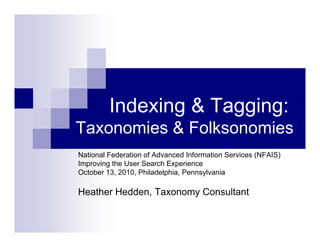Mais conteúdo relacionado Semelhante a Taxonomies and Folksonomies (20) Mais de Heather Hedden (14) 1. Indexing & Tagging:
Taxonomies & Folksonomies
National Federation of Advanced Information Services (NFAIS)
Improving the User Search Experience
October 13, 2010, Philadelphia, Pennsylvania
Heather Hedden, Taxonomy Consultant
2. Heather Hedden’s Background
Periodical database indexer for Information Access
Company (IAC): Trade & Industry and PROMT
Controlled vocabulary editor, IAC/Gale
Freelance indexer and taxonomy consultant
Taxonomy manager, Viziant and First Wind
Continuing education instructor, Simmons GSLIS
Author, The Accidental Taxonomist
© 2010 Heather Hedden 2
4. Definitions
Controlled Vocabulary – A controlled list of terms for
concepts, usually with nonpreferred terms (“synonyms”).
May or may not have structure and relationships
between terms.
Broader and includes taxonomies.
Taxonomy – A hierarchical structure of terms, which
may or many not include nonpreferred terms.
Has popularly replaced “controlled vocabulary” as a
broader concept, which may or may not be
hierarchical.
© 2010 Heather Hedden 4
5. Indexing
Closed does not use CV; open does
Trained, dedicated indexers
Indexing guidelines and policies used
Controlled vocabularies designed to support
Indexer-focused scope notes
Nonpreferred terms, displayed
Extensive hierarchical & associative relationships
Browsable, alphabetical display, type-ahead, etc.
© 2010 Heather Hedden 5
6. Indexers and Index Terms
Indexers are closest to the content
They see new concepts and terminology
They need methods of:
suggesting additional nonpreferred terms and
relationships between terms
suggesting new terms to add to the controlled
vocabulary
adding terms that supplement the controlled
vocabulary
© 2010 Heather Hedden 6
7. Levels of Vocabulary Management
1. Only controlled vocabulary used
Indexer suggests terms for approval prior to use.
2. Controlled vocabulary plus unapproved terms
Indexer may use terms prior to approval.
3. Controlled vocabulary plus keywords
Indexer supplements with terms never reviewed.
4. Controlled vocabulary plus shared keywords
Indexer supplements with terms never reviewed, but
re-usable.
© 2010 Heather Hedden 7
8. Levels of Vocabulary Management
1. Only controlled vocabulary used
Simple to manage and implement
Indexers email taxonomist with suggestions
For small controlled vocabularies
For limited scope, relatively static content
For small indexing operations
© 2010 Heather Hedden 8
9. Levels of Vocabulary Management
2. Controlled vocabulary plus unapproved terms
Indexer may create “candidate”, “unapproved,” or
“override terms” for immediate use, but also entered into
the system for taxonomist review
Unapproved indexed terms could convert to nonpreferred
terms.
Can be restricted to only certain types of terms (usually
named entities) or all terms
For large indexing operations, large controlled
vocabularies, extensive content
More technological complex to implement
© 2010 Heather Hedden 9
10. Levels of Vocabulary Management
3. Controlled vocabulary plus keywords
Indexer supplements controlled vocabulary indexing with
any keywords entered into a separate field
Keywords may be for new concepts, but are often for
more specific concepts and names
Keywords do not become part of the controlled
vocabulary. Taxonomist may or may not look at them.
Varies: (a) more indexing is with controlled vocabulary or
(b) more with keywords and CV is only broad categories
Less indexing technology, but more complex end-user
retrieval options (3 types: taxonomy, keywords, freetext)
Variants/synonyms are not controlled, redundant
© 2010 Heather Hedden 10
11. Levels of Vocabulary Management
4. Controlled vocabulary and shared keywords
Indexer supplements controlled vocabulary indexing with
any keywords entered into a separate field
Keywords do not become part of the controlled
vocabulary, but are stored in another database.
All keywords become immediately available for all
indexers to use and reuse
Indexers can browse the list of previously used
keywords; redundancies are reduced, not eliminated
© 2010 Heather Hedden 11
12. Folksonomy
Shared keywords, created and shared by those “indexing”
Indexing is not by indexers, but by end-users, consumers
of the content.
Common people, the “folk.”
“Tagging”
Users might also contribute structure, creating
(hierarchical) relationships
Originally defined as:
“user-created bottom-up categorical structure development
with an emergent thesaurus”
--Thomas Vander Wal, July 2004
© 2010 Heather Hedden 12
14. Folksonomy: Where used?
Public web sites of high volume content and users:
Delicious (http://delicious.com)
Connotea (www.connotea.org)
Diigo (www.diigo.com)
Flickr (www.flickr.com)
LibraryThing (www.librarything.com)
Large enterprises that want to foster collaboration and
innovation
Subscription content providers?
© 2010 Heather Hedden 14
15. Social Tagging
Also called collaborative tagging, social classification,
social indexing
Folksonomies plus Web 2.0/social networking features
Social communities can be built around shared sets of
popular content or popular tags
Tags for popularity ratings
Now moving into enterprises
© 2010 Heather Hedden 15
16. Folksonomies/Social tagging
Advantages
Reflects trends, up-to-date, can monitor
change and popularity. Dynamic.
Cheaper and quicker than building and
maintaining a taxonomy
Facilitates workplace democracy and the
distribution of management tasks
Responsive to user needs
© 2010 Heather Hedden 16
17. Folksonomies/Social tagging
Disadvantages
Inconsistent – precision & recall deficiencies
Biased
Requires critical mass of involvement to be
useful
Does not scale well to a large volume of
content
© 2010 Heather Hedden 17
18. Folksonomies/Social tagging
Solutions/trends:
Some degree of vocabulary control
Applicable to certain areas of content, not all
Partial vocabulary control:
Dual taxonomy & folksonomy system
Requires policy of taxonomy first
Single vocabulary system with some terms
managed/edited, and some not (yet)
like a wiki with editors
© 2010 Heather Hedden 18
19. Conclusions
Different people often apply taxonomies or
folksonomies.
Taxonomies and Folksonomies may supplement
each other.
Technology facilitates the application of both.
Users understand the distinction and can use
both.
© 2010 Heather Hedden 19

